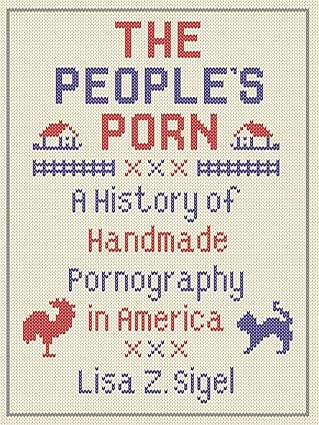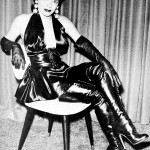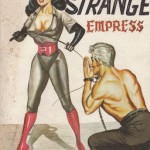
Sigel, Lisa Z. 2020. The People’s Porn : A History of Handmade Pornography in America. London: Reaktion Books. Amazon
In the early 21st century, we think of pornography as a ubiquitous, mass-produced, and corporatized phenomenon. Sites like PornHub present the viewer with vast quantities, individually tagged according to theme and sexual act. Advances in video production and distribution technology means almost anybody can make and consume sexual content with a high degree of technical quality and specificity.
Sigel’s book explores an entire history of what might be called “craft” or “artisanal” erotica, produced in single items or small sets, and using a wide variety of media, from carved whalebone to modified mass-produced photos to handmade garments. Many of the items discussed in the book aren’t “erotica” in the usual sense, i.e. items intended to arouse the viewer, perhaps as an aid to masturbation. These artifacts, such as a carved wooden figure of Abraham Lincoln with an erection, might more accurately be described as “adult novelties”.
Objects that exposed masturbation, uncovered sexual organs, and recovered hidden sexual histories tended to work through shock value, as if their goal would be a surprised bark of laughter. In articulating sex through a wink and a leer, homemade and handmade objects portrayed a sexuality both unsentimental and knowing. [Pg.209]
Even if crude (in many senses of the word), these objects said something about sexual culture in the past.
For our purposes, handmade porn is a medium for unconventional sexuality that is sadomasochistic or fetishistic. “…historians have not been able to differentiate demand from supply and have instead assumed that the pornography people bought was the pornography they wanted.” [Pg.18] If mainstream pornography won’t answer the desires of certain individuals, they will find it elsewhere (as in the collectors of damsel-in-distress stills from mainstream media who frequented the Klaws’ Movie Star News shop) or create their own by altering existing photos or illustration.
The visualization of BDSM made itself felt even in girlie magazines like Frolic that fitted into the cheesecake category and featured naked and semi-naked women. One individual took select images from an issue of the magazine and altered them. […] subsequent remade images draw the models as bound, shackled, gagged and chained […]. The retoucher had clearly flipped through the magazine, picking out the specific women he wanted to enslave. […] This version of Frolic shows an underlying overlap between pin-up poses and bondage poses; women often posed with their arms crossed in front of them, on their hands and knees, with their necks elongated. With just a marker pen, the retoucher could add chains, shackles, manacles, and collars […], transforming a widely available cheesecake magazine into the much harder to find BDSM publication. [Pg.79-80]
Beefcake magazines of the same era were altered by hand to reinstate the penises that were so carefully excluded from the published image. I recall an adult magazine in the 1990s showing an example of hand-modified porn: professional images of women in lingerie (possibly clipped from a catalog) with bondage gear rather crudely added by an unknown artist (possibly with oil paints). It seems strange today that anyone would go to that much trouble to possess bondage imagery.
People responded to print culture by reusing ideas that they encountered in print as the basis for their own stories of self. They also altered images to express a sexuality that they saw hidden in material culture. In other words, people made their own sexual stories out of commercial foundations. [Pg.71-2]
One of the oddities of sexual history is that in America, print pornography was imported from Europe, and not produced domestically, until the mid 19th century.
By the nineteenth century, imported and reprinted versions of European erotic novels like The Lustful Turk (1828) and Memoirs of a Woman of Pleasure (Fanny Hill; 1748) were circulating in Boston and New York. […] … by the 1840s sporting or flash culture — an urban culture of rogues and swindlers, deceit and decadence — began to generate racy publications. [Pg.28]
American pornography was well established by the end of the nineteenth century, but pornographic productions would still be measured in print runs of three digits and remained marginal compared to other sorts of commercial culture like ladies’ magazines, boys’ papers, and postcard views of exotic locales.[Pg.29]
Mass pornography, often aspirational and/or sentimental, remained different from folk porn.
Handmade and homemade objects speak to an individual’s ability to gesture towards desire, rather than the connoisseur’s ability to pick from a range of desires or to purchase objects to suit one’s taste. [Pg.53]
Finding examples of these objects can be difficult. They were single or limited productions, and often deliberately destroyed or just abandoned. Every so often, the Kinsey Institute would get a shipment of objects of uncertain provenance, such as the handwritten and hand-typed manuscripts of erotic stories in the “BEM collection” donated in the 1960s. Kinsey archivists have sorted them into groups with names like “the Red Binding Series” and “the Beige Humiliation Series”. “As with the broader corpus of British pornography, a large proportion of the pamphlets focus on torture and humiliation. […] Stories included plots driven by the desire to sexually humiliate and dominate women, bestiality, rape and torture, and even sexual murder.” [Pg.61]
(The diaries of Australian composer Percy Grainger from the 1930s mentioned he would use a hectograph to copy adult stories, including flagellation.)
A good portion of Sigel’s book examines the pornography created by men in prison, confiscated by guards and collected and studied by the Kinsey Institute.
In contrast to what they brought with them [i.e. conventional cheesecake and girly images], prisoners made objects that illustrated far more complicated, confusing, and disturbing ideas about sexuality. [Pg.121]
Prisoners created images that, instead of escaping into fantastic environments, recreated more carceral situations.
It should come as no surprise that some of these materials displayed a willfully violent sexuality that refuses to see the object of their desires as autonomous subjects. […]
One hand-drawn pamphlet uses institutional scrap paper to create an alternative version of a Dick and Jane children’s story. […] The prison version, confiscated from Leavenworth Federal Penitentiary in 1963, describes the imprisonment of Jane, her beating, and Dick’s sexual dominance over her as he rapes her vaginally, anally, and then orally, over her continual protests and cries of pain. In a strange displacement given that it was rendered on scrap prison stationary, the pamphlet documents Jane’s eventual imprisonment and bondage. [Pg.140]
Another prison pamphlet, “I was a White Slave for Mexico”, “describes sexual acts from the outside in a way that is strangely disembodied in that it focuses on the violation of bodily integrity. Rather than detailing what sex might feel like for men or emphasizing how it felt to inhabit a male body, the account focuses on the woman’s penetration and fear.” [Pg.145]
The articulation of types of rape and the geometric progression of perpetrators that ultimately becomes just a number per orifice — fourteen men here, six there, and four elsewhere — makes it clear that the writer cared less about the act that the massing of men. Rape gains meaning through numbers, as if the writer found something arousing through the removal of individuality. Perhaps the writer found arousing a mass extirpation of whiteness through racialized mass rape, or perhaps mass rape created male solidarity in the subjugation of women. Regardless, the geometric progression deepened a sense of watching sex rather than experiencing sex because the writer visualizes penetration through numbers. [Pg. 145]
(The similarities to the prison writings of the Marquis de Sade are so strong, I’m surprised Sigel didn’t mention them.)
Men [in prison] took the ideas of limitation, confinement, and the carceral state and used them in their pornography. Physically imprisoned men extended the ideation of the prison into their sexual desires. Desire often looked like the imprisonment, shackling, and pain of others. Imprisonment and desire were woven together so firmly that they substantiated each other. [Pg.161]
Sigel sees some of this outsider art as a form of satire, such as a drawing of a woman with a “self-raping machine”:
The satire seems to mock advertising copy, mechanical culture, men’s understandings of women’s desires, and women’s desires themselves. The artifact documents a moment in which the language of violation, rape and “meat cutting” were seen as daring and subversive and in which the frenzied and chaotic delivery of satire seemed cutting-edge. Moreover, the language of the satire — blunt, abrasive, and purposely offensive — demonstrates a way of seeing sex as embedded in a politics of politeness that the writer sought to attack. Rather than whispering, this object shouts about sex in an intentionally offensive way. [Pg.190]
If what we usually think of as pornography today can be traced back to the elite novels like Therese Philosophe written and read by libertines and would-be libertines in the 18th century, the artifacts Sigel discusses are a counter-example of the underclass articulating their own desires:
That radicalism might look inchoate compared with the formal radicalism of Enlightenment pornographers and their contributions to anti-clerical and anti-monarchical agitation, but handmade and homemade pornography existed as a sort of democratic sexual expression that refused quiescence. [Pg.64]
If commercial pornography spoke of cosmopolitan pleasures, vernacular pornography spoke of other sorts of sexual pleasures — a good joke, an easy feel, an erotic sight, or a quick poke. These objects show that people saw the world around them as highly sexualized and conceived of a sexuality both rampant and creative. [Pg.65]
The boundaries between mass-produced and privately-made erotica is “always-already” blurry. Novels like Fanny Hill might have been published commercially, but they were pirated so many times, in so many editions, that they became a kind of folk porn. John “Willie” Coutts made his Bizarre magazine basically as what would be called a ‘zine today, and sold it out of the trunk of his car, probably for very little profit. Coutts was an example of the right combination of artistic talent (in illustration and photography), technical skill, devotion to a popular-enough kink, and enough business savvy to make ongoing production of a high-quality product viable, if not profitable.
It was people like the Klaws who recognized this emerging subculture and its media productions and figured out a way to monetize it, though they made a point of playing it safe by having their models never being nude and always wearing multiple pairs of panties to avoid any censurable sexuality. Full-color glossy magazines came in the late 60s, the product of corporatization of the industry that supported the subculture. You can see a similar process with the silent stag films produced in limited numbers and distributed via non-commercial networks, to mass produced video porn in the 80s.
Nowadays, a sexual niche barely has time to take a breath before it becomes another niche category on PornHub or OnlyFans or Archive Of Our Own. Nonetheless, there are still multiple dialectics at work in pornography, between those who want it to be sentimental or aspirational, and those who want it to be shocking.




[…] The History of BDSM, The People’s Porn: A History of Handmade Pornography in America, by Lisa Z. Sigel […]
[…] The History of BDSM, The People’s Porn: A History of Handmade Pornography in America, by Lisa Z. Sigel […]
[…] The History of BDSM, The People’s Porn: A History of Handmade Pornography in America, by Lisa Z. Sigel […]
[…] The History of BDSM, The People’s Porn: A History of Handmade Pornography in America, by Lisa Z. Sigel […]
[…] The History of BDSM, The People’s Porn: A History of Handmade Pornography in America, by Lisa Z. Sigel […]